Yesterday marked the 64th anniversary of the Feb. 28, 1947 Incident, also known as the 228 Incident. It was also the inauguration of the National 228 Memorial Museum, thus starting a new page in the history of Taiwan. There is a saying that “the past is the key to the future.” Sixty-four years ago, racial discrimination and conflict were rampant in Taiwan; today, rather than opening old wounds for the families of victims of the 228 Incident, the establishment of the National 228 Memorial Museum tries to restore historical memory by converting sorrow into a positive force and passing down the historical significance of the 228 Incident to the next generation.
昨天是發生於一九四七年二二八事件六十四週年紀念日,也是二二八國家紀念館正式開館營運,開啟台灣歷史新頁。歷史有句名言:「以古為鏡,可以知興替。」六十四年前,族群對立,六十四年後的今天,喚回歷史記憶的不是二二八受難者與家屬的悲傷憤怒,而是超越心靈傷痛的傳承意義。
To gain insight into Taiwan’s history, one must understand the history of the 228 Incident — the most tragic and unforgettable incident in Taiwanese history and the deepest and most painful historical wound in Taiwanese society. From being a forbidden topic during the 38 years of Martial Law to having a national museum dedicated to it, the 228 Incident clearly represents a watershed for Taiwan’s democratization process. Many books have been written on the 228 Incident, and there is also a symphonic poem, 1947 Overture, composed by Tyzen Hsiao. The overture incorporates poet Lee Min-yung’s poem Love and Peace about healing the wounds of history, and Pastor John Jyigiokk Tin’s Taiwan the Green, expressing a hope for the rebirth of Formosa.
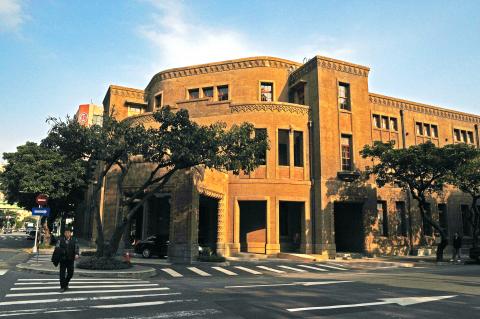
Photo: courtesy of the 228 Memorial Foundation
照片: 二二八事件紀念基金會提供
要了解台灣歷史,必定少不了國史上最悲慘、最難以忘懷的二二八事件,它也是台灣社會最深、最痛的歷史傷痕。從台灣戒嚴三十八年期間的禁忌話題,到二二八國家紀念館開館,台灣民主的過程歷歷可見。各式二二八相關書籍文獻紛紛出版,甚至有蕭泰然教授創作如詩如畫的音樂《一九四七序曲》,結合了詩人李敏勇溫暖詩詞《愛與希望》撫平傷痛與鄭兒玉牧師《台灣翠青》,期望美麗寶島的重生。
In 2006, the Ministry of Education initiated plans to establish a National 228 Memorial Museum on 54, Nanhai Road, and it entrusted the 228 Memorial Foundation with the museum’s management and operation. Prior to 2004, the foundation’s mission was mainly to provide monetary compensation and emotional consolation, and to restore the good names of the victims of the massacre. Between 2004 and 2007, efforts were made to make the history of the 228 Incident more accessible to the public by holding academic conferences and memorial events to commemorate the human rights victims. In 2007, the foundation shifted its mission and began focusing on fact finding, the collection of historical documents, and cultural, historical, educational, and human rights work and international academic exchanges as a long-term project. Inaugurated during Taiwan’s centennial celebrations, the National 228 Memorial Museum has signed a memorandum of cooperation with the Taipei 228 Memorial Museum, which is under the supervision of Taipei City Government’s Department of Cultural Affairs. Within walking distance of each other, the two museums will share resources, cooperate with each other, and try to avoid the repetition of content in their respective exhibitions.

Photo: courtesy of the 228 Memorial Foundation
照片:二二八事件紀念基金會提供
行政院教育部於二零零六年開始籌設二二八國家紀念館,核定館址在南海路五十四號,並委託二二八事件基金會經營管理。二零零四年以前,基金會以賠償和撫慰為主要業務,平反二二八受難者的名譽。二零零四年至二零零七年間,基金會致力於二二八事件歷史與社會結合,舉辦學術研討會與各項紀念活動紀念二二八人權鬥士。二零零七年以後,基金會任務轉型,以真相發掘、史料蒐集及文化、歷史、教育、人權、國際交流等工作,朝向永續經營。國家級的紀念館在建國百年啟用,並與隸屬於台北市政府文化局的台北二二八紀念館簽署合作備忘錄,讓兩座步行可及的二二八紀念館,資源共享、互補效益,並避免展覽內容重覆。
Past and present merge at 54, Nanhai Rd.
南海路五十四號的今昔
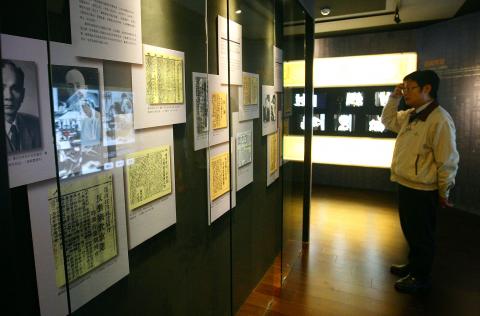
Photo: CNA
照片: 中央社
Located at 54, Nanhai Road, the National 228 Memorial Museum maintains the Taiwanese architectural style of the 1930s. The building has played different roles throughout history and is witness to how Taiwanese history has developed.
位於台北市南海路五十四號的二二八國家紀念館,保有三零年代台灣建築代表風格,述說著它在不同歷史階段所扮演的面貌與身分,見證了台灣歷史的進程。
1. Taiwan Education Association Building
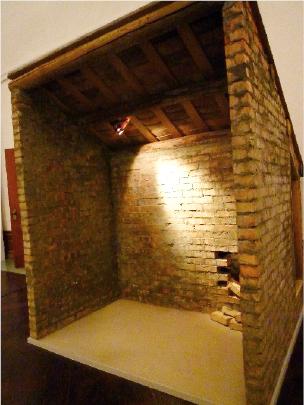
Photo: Tseng Wei-chen, Liberty Times
照片:自由時報記者曾韋禎
This building was constructed in 1931, during Japanese rule, as the Taiwan Education Association Building. It was an important venue for all sorts of lectures, exhibitions, film screenings, art exhibitions, and other events. It was regarded as an important conduit between modern art in Taiwan and the rest of the world. The “Taiwan Art Exhibition,” a major annual art event in Taiwan, was held by the Taiwan Education Association, and made artists such as Chen Cheng-po, Liao Chi-chun, Yang San-lang, Yang Shui-long, Lan Yin-ding, and Lee Mei-shu famous.
壹、台灣教育會館
這棟古蹟初建於一九三一年日據時期,原為「台灣教育會館」,是當時各式演講會會場、教育成果展示地、電影製作放映與美術展覽的重要場所,可謂台灣與世界現代藝術對話的重要窗口。過去台灣美術界年度盛事「台灣美術展覽會」,即是台灣教育會主辦,台灣前輩畫家,如陳澄波、廖繼春、楊三郎、顏水龍、藍蔭鼎、李梅樹等人,皆因此展覽而備受肯定。
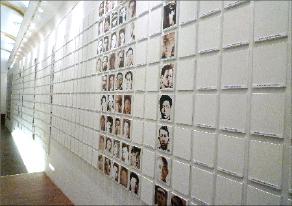
Photo: Tseng Wei-chen, Liberty Times
照片:自由時報記者曾韋禎
2. Taiwan Provincial Assembly
In 1945, the Chinese Nationalist Party (KMT) government designated Chen Yi as governor of Taiwan province. It also established the Taiwan Provincial Assembly, which met in the Taiwan Education Association Building. After the 228 Incident, of the 30 provincial assemblymen, Wang Tian-deng was captured and later died, Lin Lien-tsung went missing, and Lin Jih-kao and Ma You-yueh were incarcerated. The building is therefore very significant for the story of the Taiwanese pursuit of democracy after World War II and is an important 228 Incident historical site. In 1949, the Taiwan Education Association took over the management of the building, which continued to be used for free by the Taiwan Province Provisional Assembly and later the Taiwan Provincial Assembly.
貳、台灣省參議會
一九四五年,國民黨政府任命陳儀為「台灣省行政長官」,同時設立「台灣省參議會」,並借用「台灣教育會館」作為辦公與開會場所。二二八事件發生後,三十名省參議員中,有王添灯被捕喪生、林連宗失蹤,及林日高、馬有岳受到拘禁等事實,此館因而成為戰後台灣人追求民主的重要見證及二二八事件的重要歷史現場。一九四九年,此館由「台灣省教育會」接收,惟建物卻仍由「台灣省參議會」與改選後的「台灣省臨時省議會」繼續無償使用。
3. The United States Information Service
The United States Information Agency moved into the building in 1959, a year after the Taiwan Province Provisional Assembly moved out. After the US ended diplomatic ties with Taipei in 1979, the US embassy in Taiwan was transformed to the non-official American Cultural Center (ACC), and continued to hold cultural, educational, and business exchange events. By the end of 1991, the ACC moved out due to the Nanhai Renewal Project, a project that was later canceled because of protests from cultural circles who opposed its being rebuilt. The building was once rented by the Scouts of China, and then again rented by the ACC in 1993. The building was declared a third-class national historic site in the same year. The United States Information Service held official US government data and information about study in the US, and it also provided part of its office space for arts and literary exhibitions. Following the eclectic exhibitions held by the “Taiwan Education Association” during Japanese rule, in the 1960s, when information from the outside world was relatively suppressed, the center also played a role in pushing Taiwan’s arts and literary development.
參、美國在台新聞處
一九五九年,「美國在台新聞處」在臨時省議會遷走後次年遷入,此後二十年間,這裡成為台海緊張時期,台灣獲知歐美消息的重要管道。一九七九年中美斷交,原本駐台的美國大使館改為非官方性質的「美國文化中心」,持續文化、教育、商務相關交流活動。一九九一年底,省教育廳為配合「南海更新計畫」擬改建大樓,「美國文化中心」遷出,卻因文化界反對改建而擱置;其後一度由「中國童子軍總部」承租,一九九三年再由「美國文化中心」續租,此建物也在同年被指定為三級古蹟。「美國在台新聞處」除有完整的美國政府官方資料及赴美留學資訊外,也提供部分場地作為藝文及美術展覽之用。繼日治時期「教育會館」的多元展覽功能之後,此中心在資訊相對封閉的六零年代,扮演推動台灣現代藝術的另一推手。
4. National 228 Memorial Museum
The National 228 Memorial Museum, whose establishment was approved by the Cabinet in July 2006, was finally inaugurated yesterday. The historic site, filled with the traces of history, shows the changes through the years. According to Allan J. Shackleton’s book Formosa Calling, disillusioned Taiwanese people at the time would often say, “Out with the Japanese dogs, in with the Chinese pigs.” The opening of the new national museum symbolizes a wish that Taiwan will be able to “move beyond the 228 Incident and embrace democracy and human rights.”
肆、二二八國家紀念館
二零零六年七月行政院正式核定為「二二八國家紀念館」,終於於昨日正式對外開館,在這個充滿歷史軌跡的古蹟內,展出歷年的演變。讓福爾摩沙的呼喚“Formosa calling”找到出口,從暴亂中新生。根據艾倫‧詹姆士‧謝克頓寫的《福爾摩沙的呼喚》,當時失望的台灣人常感嘆,「走了日本狗、來了中國豬」。希望國家館的成立,象徵今天「走了二二八歷史心結,來了民主與人權。」
Exhibitions and Historical Objects
展覽與文物典藏
There are two exhibition areas in the National 228 Memorial Museum, one for the permanent exhibition and the other for special exhibitions. The former presents exhibition materials chronologically and reconstructs scenes from the 228 Incident through a combination of traditional and interactive digital displays. The special exhibition focuses on different periods and shows the history of the site itself. In addition to the exhibitions, there are also historical objects such as documents, files, photos, videos, publications, art works, and folk arts. People can revisit history through the exhibitions and learn the history of Taiwan’s democracy.
二二八國家紀念館內有兩個展場,包含館內常態展與特展。常態展區以歷史步道的意象,結合傳統及數位互動式展現手法,還原二二八歷史現場。特展則是針對不同階段,呈現古蹟本體的歷史脈絡。除展覽外,另設有文物典藏,包含文件、檔案、相片、影片、著作、藝術品及民俗文物等。藉由館內珍藏,民眾可以重返歷史現場,並學習到台灣步向民主的歷史記憶。
“Division and Rebirth”
「斷裂與再生」
Many people are certain to sympathize with the sorrow and resentment of the families of the victims of the 228 Incident. In the lyrics of a Taiwanese song If I Open My Heart to the World written in 1954, “If I open my heart to the world, I will see the glorious colors of a spring day.” Only if we face up to the past — forgive but not forget — can we restore the historical truth, escape from under the shadow of the past, and learn the lessons of the 228 Incident. Only if we transcend ethnic divides can the brand new National 228 Memorial Museum, which commemorates a painful episode in Taiwan’s history, accomplish its new mission in the new era, for the benefit of Taiwan.
面對受難者家屬的悲傷憤怒,想必許多人能感同身受。一首一九五四年發表的台灣歌謠《阮若打開心內的門窗》唱著「阮若打開心內的門,就會看見五彩的春光。」只有選擇原諒而不遺忘,打開內心的門窗,才能還原歷史,走出悲情二二八,創造二二八的時代意義。只有不分族群,才能讓嶄新的二二八國家紀念館,追悼紀念這段沉痛歷史同時,賦予新時代與新使命,持續守護台灣。
(WRITTEN BY LIN YA-TI, TAIPEI TIMES / 台北時報林亞蒂編撰)
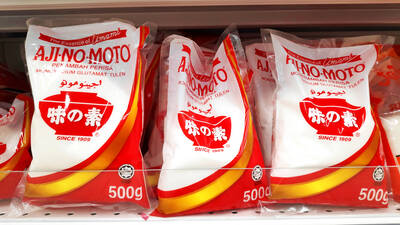
Monosodium glutamate (MSG) has been used in cooking for over a century to enhance flavor. It is often found in Chinese dishes and many other cuisines. Despite its common use, many people misunderstand the safety of MSG. The bad __1__ of MSG started in the late 1960s, when a letter to the New England Journal of Medicine described symptoms like a racing heart, weakness, and numbness after the writer ate Northern Chinese food. While no specific cause was __2__, a series of questionable studies in 1968 began to point the finger at MSG. In one such study, neurologist Herbert Schaumburg and

A: The World Expo 2025 is about to open in Osaka. Is Taiwan going to participate in the event too? B: Sure, the Taiwan External Trade Development Council (TAITRA) will launch a Taiwan pavilion named “Tech World.” A: That sounds cool, and it can showcase our national strength in technology. B: The theme is “Connecting the world to create better future lives together.” The pavilion aims to attract over one million visitors. A: I hope humans can really create better future lives through this year’s fair. A: 2025年世博會即將開幕,這次台灣也會參加嗎? B: 當然啦,外貿協會的台灣館將以「Tech World」名義參展! A: 聽起來蠻酷的,應該是想強調台灣的科技實力。 B: 策展主題則是:「連結世界,共創未來美好生活」,希望能吸引到100萬人次參訪。 A: 希望藉由這次世博會,人類真的能共創美好生活。 (By Eddy Chang, Taipei Times/台北時報張迪)

Even as he grows older, Microsoft founder Bill Gates still fondly remembers the catalytic computer code he wrote 50 years ago that opened up a new frontier in technology. Although the code that Gates printed out on a teletype machine may look crude compared to what’s powering today’s artificial intelligence platforms, it played a critical role in creating Microsoft in April 1975 — a golden anniversary that the Redmond, Washington, company celebrated on April 4. Gates, 69, set the stage for that jubilee with a blog post reminiscing on how he and his old high school friend — the late Paul Allen

The study had several issues. Small sample sizes made it hard to draw __7__ conclusions. Additionally, taking a __8__ like pure MSG on an empty stomach is likely to make a person ill in any case. Choosing individuals who already had a history of the symptoms could have created a bias because they were likely to __9__ the reactions again. When real scientific research on the effects of MSG was eventually done, many of the myths surrounding it were proven __10__. The U.S. Food and Drug Administration and other global organizations have found MSG safe to eat. Today, MSG